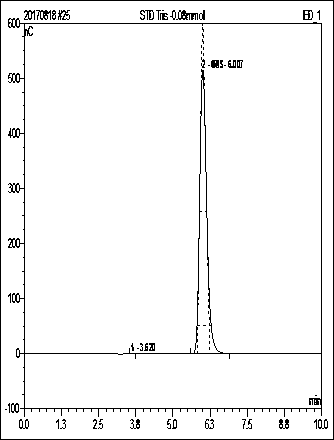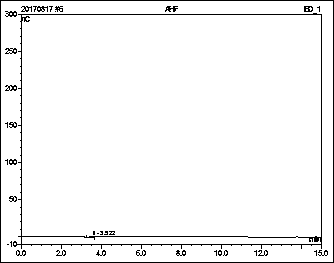Method of detecting trihydroxymethyl aminomethane (Tris) in bioproduct by means of ion chromatography
A technology of tris(hydroxymethyl)aminomethane and ion chromatography, applied in the field of analysis and detection, can solve the problems of inability to quantitatively detect Tris, high limit of quantification, interference, etc., and achieve the effect of low detection limit, low quantitative limit and good selectivity.
- Summary
- Abstract
- Description
- Claims
- Application Information
AI Technical Summary
Problems solved by technology
Method used
Image
Examples
Embodiment 1
[0023] The test sample is freeze-dried human thrombin produced by Shanghai RAAS Blood Products Co., Ltd., reconstituted with water for injection according to the regulations, diluted 500 times, and injected for detection. The instrument used in the experiment was ICS 5000 ion chromatograph from Thermo Fisher Company, and the chromatographic conditions were: Dianne Ionpac CS16 cation exchange column, including analytical column (250mm×5mm) and guard column (50mm×5mm), and the column temperature was 30°C; The post-column rehydration derivation method is adopted, the post-column rehydration is 500mmol / L sodium hydroxide solution; the mobile phase is methanesulfonic acid solution, and the flow rate of the mobile phase is 1.0mL / min; the detector is a pulsed amperometric detector with Au as the electrode , the Ag-AgCl electrode is the reference electrode, and the waveform is Carbohydrates; the Tris ion chromatogram is shown in figure 1 .
[0024] Standard solutions of different con...
Embodiment 2
[0026] The test sample is a 1% glycine solution, which is diluted 500 times and injected for detection. The instrument used in the experiment is the ICS 5000 ion chromatograph of ThermoFisher Company, and the chromatographic conditions are: Dianne Ionpac CS16 cation exchange column, including the analytical column (250mm × 5mm) and the guard column (50mm × 5mm), and the column temperature is 30°C; Post-column replenishment derivation method, the post-column replenishment is 500mmol / L sodium hydroxide solution; the mobile phase is methanesulfonic acid solution, and the flow rate of the mobile phase is 1.0mL / min; the detector is a pulsed amperometric detector with Au as the electrode, The Ag-AgCl electrode is the reference electrode, and the waveform is Carbohydrates; the Tris ion chromatogram is shown in figure 2 .
[0027] Because the pulsed amperometric detector can detect small molecular compounds containing hydroxyl and amino groups, it can be seen from the figure that th...
Embodiment 3
[0029] The test sample is freeze-dried human blood coagulation factor FVIII (AHF) produced by Shanghai Raas Blood Products Co., Ltd., reconstituted with water for injection according to the regulations, diluted 500 times, and injected for detection. The instrument used in the experiment is the ICS5000 ion chromatograph of Thermo Fisher Company, and the chromatographic conditions are: Dianne Ionpac CS16 cation exchange column, including the analytical column (250mm × 5mm) and the guard column (50mm × 5mm), and the column temperature is 30°C; Post-column replenishment derivation method, the post-column replenishment is 500mmol / L sodium hydroxide solution; the mobile phase is methanesulfonic acid solution, and the flow rate of the mobile phase is 1.0mL / min; the detector is a pulsed amperometric detector with Au as the electrode, The Ag-AgCl electrode is the reference electrode, and the waveform is Carbohydrates; the Tris ion chromatogram is shown in image 3 .
[0030] No Tris w...
PUM
 Login to View More
Login to View More Abstract
Description
Claims
Application Information
 Login to View More
Login to View More - R&D
- Intellectual Property
- Life Sciences
- Materials
- Tech Scout
- Unparalleled Data Quality
- Higher Quality Content
- 60% Fewer Hallucinations
Browse by: Latest US Patents, China's latest patents, Technical Efficacy Thesaurus, Application Domain, Technology Topic, Popular Technical Reports.
© 2025 PatSnap. All rights reserved.Legal|Privacy policy|Modern Slavery Act Transparency Statement|Sitemap|About US| Contact US: help@patsnap.com



